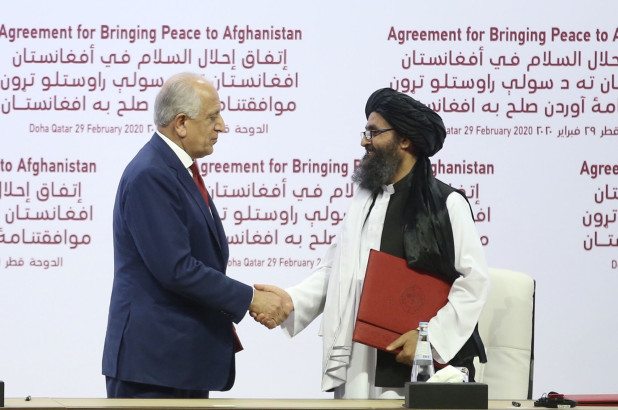A new survey shows that a large number of Afghans are cynical about peace talks, saying that the talks will not necessarily end conflict in Afghanistan and bring peace to the country. Based on findings of the study, 63 percent of the participants said that they were unaware of peace agendas discussed behind closed doors between the parties.
The research conducted by Rumi Consultancy has polled a sample of 600 participants (originally from 22 provinces) in eight provinces over the course of three months.
According to the survey, 85 percent of the participants had heard about the peace talks and the remaining 15 percent had not. 61 percent of the interviewers have reported social media as their preferred source of information.
“46% of participants considered a successful ceasefire a vital test of whether the peace talks would make real progress,” part of the study reads, adding that over one-third of participants see the talks as a secure withdrawal for US forces from Afghanistan.
This comes as the Taliban have ramped up military campaign against Afghan security forces after the political leaders of the militant group signed a peace deal with the United States on February 29 in Doha, capital of Qatar.
Since then, the Afghan government has repeatedly appealed to the group and called on other international unions to encourage the Taliban to cease hostilities and accept a nationwide ceasefire. In his latest tweets today, May 06, President Ghani’s spokesperson, Sediq Sediqi, described the Taliban’s violence as “main hurdle” against the peace process.
The survey has found that “one major reason for the suspicion and lack of acceptance surrounding the peace talks is the lack of reliable, publicly available, and easily accessible information.” It recommends that policymakers and other stakeholders must dramatically revamp the approach they have so far resorted to as means of communicating their messages for the peace process.
“Stakeholders must adopt a two-pronged strategy of broadly targeted messages aimed at reassuring the Afghan public and specifically targeted messages that will resonate uniquely with different segments of Afghanistan’s diverse population,” the research recommends, calling for creating a “two-way channel” through engaging local leaders and religious authorities.
Drastic increase in violence
Prisoner exchange between the Afghan government and the Taliban, reduction in violence, and holding intra-Afghan talks were components of the US-Taliban peace deal on which all parties were expected to work. Though the Taliban have seemingly decreased their complex high profile attacks in major cities, the militants have drastically intensified deadly offensive attacks on Afghan security forces in country sides.
In addition to the Afghan government officials, the US military officials have also repeatedly accused the militant group of not abiding by the commitments they made in the peace agreement, particularly in regard with reducing the violence by 80 percent.
Issuing a long statement in response to the Taliban spokesperson, Zabihullah Mujahid, the US Forces in Afghanistan said on May 02 that the world has not seen a decrease, but a “drastic increase” in violence since February 29.
“During those long negotiations there were written and spoken commitments,” part of the statement stated while adding that the US forces recognize the reduction of violence against cities and against coalition forces. “But we spoke of All sides reducing violence by as much as 80% to pave the way for peace talks,” the statement pointed out to what it previously described as spoken commitment between the Taliban and the US.
In one of Taliban’s latest attacks, at least five Afghan security forces were killed when their outpost was detonated by car bomb in Nahr-e-Siraj district of the southern Helmand province on Monday, May 04, according to Omer Zawak, spokesperson for Helmand governor.
Last week, the Office of Afghanistan’s National Security Adviser told Associated Press news agency that Taliban had carried out 2,804 attacks since the Taliban-US peace deal. From April 01 up until last Monday, nearly 60 Afghan security forces lost their lives in multiple Taliban attacks across the country.
Prisoner swap continues despite violence
Though the Taliban have put an end to violence against Afghan security forces, the Afghan government earlier last week announced that it would release more Taliban prisoners in coming days.
The Afghan government has released a total of 902 Taliban prisoners while the Taliban have freed a total of 132 prisoners of the government, but both parties claim that the progress in prisoner swap does not go as smooth as it was expected.
The Afghan government has confirmed the release of 106 prisoners by the Taliban whom it says are mostly civilians.
Javid Faisal, spokesperson for Office of the National Security Council, has reiterated many times that all the Taliban prisoners are released in line with President Ghani’s decree that stipulated their release considering their age, health condition, and imprisonment period.
The release plan was primarily rejected by spokesperson of the Taliban political office in Doha, Suhail Shaheen, noting that the group had not agreed on conditional release of their prisoners. He added that they wanted all 5,000 Taliban prisoners should be released before start of the intra-Afghan talks, as per the US-Taliban agreement.
According to President Ghani’s decree, only 1,500 Taliban prisoners will be released in a phased process before start of the intra-Afghan talks. The remaining, 3,500 will be released during the intra-Afghan talks.




